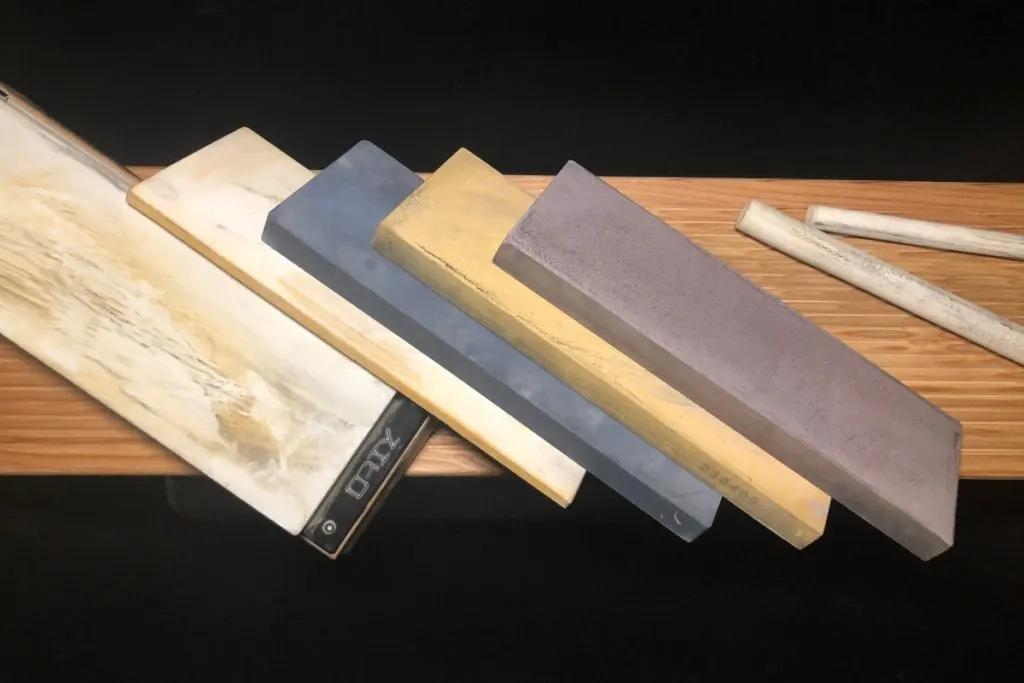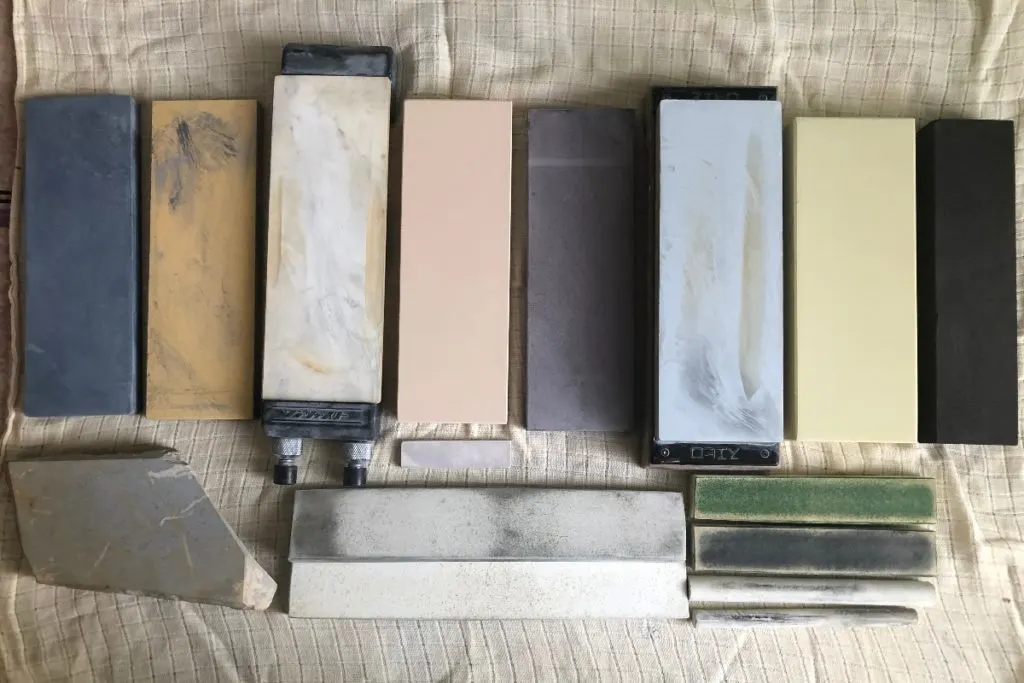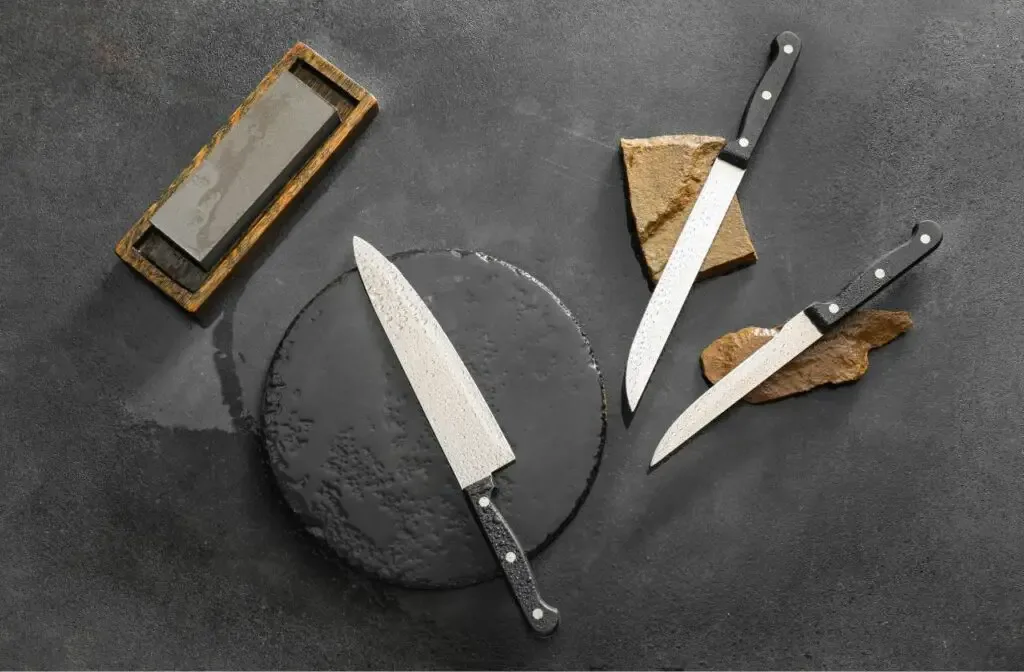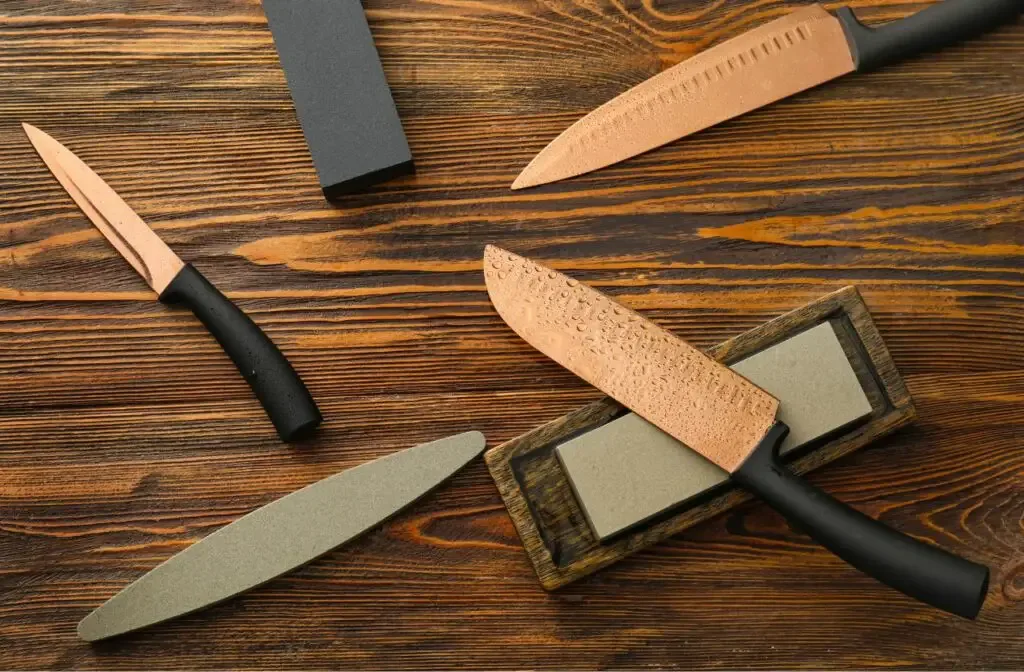Understanding whetstone grit levels can be a little confusing at first, especially when grit levels across the different stone types are not the same. A 200 grit diamond stone will cut differently from a 200 grit Waterstone. Our guide to whetstone grits and their levels will help clear up misconceptions and guide you to the best stones for your requirements.
Whetstones come in a range of grits to perform different sharpening tasks on a blade. The coarse or low-grit stones are used to fix a damaged knife edge. Medium-grit stones are used to sharpen a knife, and fine or high-grit stones are used to refine and polish the edge.
Whetstone grits can seem a daunting task to understand and decide which grits will be the most beneficial for your sharpening activities. We have recommended whetstone grits for different knife types and a sequence of stones that would be suitable for a wide variety of sharpening tasks to guide your understanding and choice.
If you are interested in buying some of the whetstones mentioned in this article we use regularly and recommend, you can find them in the table below:
| Usage | Grit Type | Best Option |
|---|---|---|
| Fixing stone | 320 grit | Shapton Kuromaku 320 |
| Establishing the Edge | 400 grit | Naniwa Chosera 400 |
| Sharpening Stone | 600 grit | Naniwa Chosera 600 |
| Sharpening Stone | 800 grit | Naniwa Chosera 800 |
| Finishing Stone | 1000 grit | Suehiro CERAX |
| Polishing Stone | 2000 grit | Shapton Kuromaku 2000 |
| Polishing Stone | 5000 grit | Shapton Kuromaku 5000 |
| Extra Polishing Stone | 8000 grit | Shapton Kuromaku 8000 |
| Mirror Polishing Stone | 12000 grit | Shapton Kuromaku 12000 |

Whetstone Grit Meaning
The grit rating on a whetstone indicates how coarse or fine the abrasive is on the stone. This rating gives the user an idea of how aggressive the stone will be in removing material from the edge of a knife or any other tool being sharpened.
The lower the grit rating on the whetstone, the coarser the abrasive will be. Coarse abrasives will quickly remove a lot of material from the knife’s cutting edge.
High grit rating stones have a much finer abrasive and are less aggressive in the amount of material they remove from the cutting edge. Extremely high grit whetstones can be used to polish the cutting edge of a knife and leave a mirror-like finish on the blade.
The mid-range grit rating whetstones will be less aggressive than low grit stones but more aggressive than high grit stones.
Fine or high-grit stones are used to refine and polish the knife’s cutting edge to take the edge to next-level sharpness and shininess.
Each of the different grit types of the whetstone is intended for different repair, sharpening, and honing tasks on a blade edge.
You will not use every grit rating during a sharpening session but only a stone of a grit rating appropriate to the task at hand.
TIP: Whetstone sharpening requires skills that are only acquired by practice and experience, but we all have to start somewhere. Check out the step-by-step guide on how to sharpen a knife on a whetstone in the article below:
Step-By-Step GUIDE: How To Sharpen A Knife With A Whetstone
Whetstone Grit Levels Explained
Whetstone grits are divided into ranges of grit levels, which are grouped into general categories of coarseness. Since these categories include a range of grit levels, it is easier to compare grits of stones of various types.
The following are the most common general coarseness categories.
| Grit Type | Grit Levels | Explanation |
|---|---|---|
| Extremely coarse | under 150 grit | It is unlikely that you would ever use a stone lower than 150 grit since this will remove too much material for sharpening purposes. |
| Coarse | 150 to 300 grit | These stones are aggressive and remove a lot of material very quickly from the knife’s edge. They are often used to repair a damaged cutting edge. |
| Medium grit | 300 to 600 grit | These stones are less aggressive and are used as part of the sharpening process to re-establish secondary bevels on the cutting edge. |
| Fine grit | 600 to 1000 grit | These stones do not remove large amounts of material from the cutting edge and are used to refine and hone the cutting edge. |
| Extra fine grit | 1000 to 2000 grit | Stones of this grit remove very little material and are used for honing an already sharp edge. |
| Ultrafine grit | 2000 to 6000 grit | These stones are used to begin the edge’s polishing process and take the knife to a higher level of sharpness. |
| Near mirror polish grit | Above 10,000 grit | These whetstones will polish the edge to a finish close to a mirror finish, enhancing the edge’s ease of slicing through the material. |
| Mirror polish | Above 10 000 grit | These stones will put a mirror finish on the cutting edge. Most people will not need to go to this level when sharpening knives, and these whetstone grits are extremely expensive stones to purchase. |
TIP: Whetstones themselves require care and maintenance to keep them performing optimally and extend their longevity. Check out the best tips on better and longer endurance of your whetstones in the article below:
14 Care Tips For Better & Longer Endurance Of Your Whetstone
How To Choose Whetstone Grit

Choosing the correct whetstone grit for the task you wish to perform on the knife can raise a dilemma for beginners to knife sharpening.
When To Use Coarse Grit Whetstones
Extremely coarse and coarse whetstones will only be used on a knife with a badly damaged edge, and the damaged section needs to be ground out of the edge. These will be stones with a grit level below 300 grit. These grit levels are often used to fix cutting edges that are chipped, cracked, or have pieces gouged out of them.
Knifemakers will also use coarse stones to establish the cutting edge bevels for the first time on a new knife. These coarse whetstones remove a lot of material from the knife’s edge very quickly. Using these stones incorrectly on a knife with an established edge can damage the edge, requiring more fixing than necessary.
It is not common for the average knife owner to use low-grit whetstones since they are used to re-establish an edge or put an edge on the knife for the first time.
Fixing a damaged edge on a knife generally requires a level of expertise beyond that of normal sharpening skills. However, it is worthwhile having a coarse stone of 300 grit available for some heavy-duty sharpening tasks.
When To Use Medium Grit Whetstones
Medium-grit whetstones between 300 and 600 grit are the most common stones to begin sharpening a dull knife.
If the knife has no major damage on the cutting edge but is simply extremely dull, medium grit stones are the place to start.
Since this category of stones has a range between 300 and 600 grit, choosing the grit within the range will be determined by the state of the knife’s edge. In most cases, choosing a less aggressive 600-grit whetstone to begin the sharpening session will be sufficient.
These stones perform the bulk of the sharpening process. Once the knife has been sharpened on these stones, it will be sharp, but the edge will still require refining on a higher grit whetstone.
When To Use Fine Grit Whetstones
Fine grit whetstones between 600 and 1000 grit are used to refine the sharp edge of a knife. In the sharpening process for a dull knife, these stones will be used after the medium grit stones.
If the knife is already sharp but has lost some of its keenness, it is not always necessary to go to a low-grit whetstone. You can start directly on the medium grit stones to touch up the edge and restore sharpness.
There is quite a significant abrasive difference between a 600-grit whetstone and a 1000-grit whetstone. For touch-ups of the edge on a sharp knife, a 1000-grit whetstone can be used. The most common grit levels used in this category are 800 and 1000-grit.
TIP: One of the important maintenance tasks is flattening the sharpening stones. Find out the complete guide about flattening whetstones in the article below:
4 Proven Ways: How To Flatten Sharpening Stone (Whetstone)
When To Use Extra Fine Grit Whetstones
Extra fine whetstones are in the range between 1000 and 2000 grit. These stones remove very little material and are more in the category of honing the edge rather than sharpening.
A knife that has been sharpened up to fine grit level whetstones will be sharp. Applying the extra-fine grit whetstones to the knife will further refine the edge and increase the level of sharpness.
Using these stones can be considered equivalent to finishing the edge on a leather strop with a polishing compound. It will serve to straighten the edge and polish the edge to a certain level, which increases the keenness of the edge.
Most knife owners would stop at this grit level after sharpening a knife with this level of grit. The knife will be sharp enough for most home, outdoor, or kitchen uses once it has been finished on these stones.
If the knife is already sharp and you simply want to hone the edge, a whetstone at this level of grit works well as a replacement for a honing rod.
When To Use Ultrafine Grit Whetstones
Ultrafine whetstones between 2000 and 6000 grits are generally considered polishing stones in most knife sharpening circles, although there are still higher whetstone grits for polishing.
Using ultrafine whetstones is usually in the realm of sharpening specialized tools such as straight razors. While knives can benefit from this level of whetstone grit, it will mostly be to polish the cutting edge to increase the ease with which the knife will pass through the item to be cut.
It is uncommon for most people who sharpen their own knives to go to this level of grit as part of the sharpening process. Generally, it is perceived to be unnecessary to take a knife to this level of sharpness unless it is for a specialized function or for the sake of aesthetics.
The price of these high-level grit whetstones also rises exponentially with the increasing grit level.
When To Use Mirror Polish Whetstones
Mirror polish whetstones range from 6000 to 10,000 grit and above. These whetstones will finish the edge to a near-mirror polish or a full mirror polish with the higher grit stones.
These whetstones are not commonly used by most people who want sharp knives. Commercial knife makers typically use these high-grit whetstones to make the knives ultra-sharp with the added aesthetic value of a gleaming mirror-like finish on the cutting edge.
It is unusual to find a whetstone above 6000 grit in the collection of stones used by people who sharpen their own knives.
The price of whetstones approaching 10,000 grit and beyond the border on the ridiculous and is generally beyond the budget for most people, given that they do not add much value to the knife’s sharpness.
TIP: While many people may be aware that they can ruin the knife if the whetstone is used incorrectly, what about ruining your whetstones when using them incorrectly? Find out the most common ways people ruin their whetstones in the article below:
5 Ways To Ruin A Whetstone (Avoid These Mistakes)
What Whetstone Grit to Buy

If you went out and purchased one of each whetstone grit available, you would inevitably bankrupt yourself unnecessarily!
You can use 3 or 4 or perhaps 5, whetstone grits at the most, which would give you the sharpening tools you need to manage most knife maintenance tasks.
The grit and type of whetstone best for your needs will often be influenced by the type of knives you have and the level of sharpness you need on the blades.
If you sharpen a wide range of knives, we recommend having at least the following whetstone grits available.
- 1 x fixing stone. A fixing stone of 320 grit will provide the ability to fix damaged cutting edges.
- 3 x sharpening stones. A 400-grit whetstone to re-establish an edge, an 800-grit whetstone to perform less aggressive sharpening, and a 1000-grit whetstone to refine the edge.
- 1 x polishing stone. A polishing stone of 2000 grit would be suitable for most people’s needs and can replace the use of a strop. However, a 6000-grit polishing stone would be more suitable if you prefer a shinier edge.
For most average sharpening needs, 1 fixing stone and the three sharpening stones mentioned would be sufficient.
If you are interested in buying some of the best whetstones for each grit mentioned in this article, you can find them in the table below:
| Usage | Grit Type | Best Option |
|---|---|---|
| Fixing stone | 320 grit | Shapton Kuromaku 320 |
| Establishing the Edge | 400 grit | Naniwa Chosera 400 |
| Sharpening Stone | 600 grit | Naniwa Chosera 600 |
| Sharpening Stone | 800 grit | Naniwa Chosera 800 |
| Finishing Stone | 1000 grit | Suehiro CERAX |
| Polishing Stone | 2000 grit | Shapton Kuromaku 2000 |
| Polishing Stone | 5000 grit | Shapton Kuromaku 5000 |
| Extra Polishing Stone | 8000 grit | Shapton Kuromaku 8000 |
| Mirror Polishing Stone | 12000 grit | Shapton Kuromaku 12000 |
BTW: If you do not want to buy each whetstone separately, we recommend buying a whetstone set. The best option is to buy the Shapton Kuromaku Whetstone Set (Amazon link) with 320-grit fixing stone, 1000-grit sharpening stone, and 5000-grit polishing stone. The alternative (cheaper) option is the Sharp Pebble Set (Amazon link) with 400, 1000, and 6000 grits.
What Grit Whetstone For Kitchen Knives
Kitchen knives are generally used for their intended purposes, which means they seldom require much repair work on the cutting edge.
Consequently, you can use fewer stones to maintain the edge of your kitchen knives. Generally, three sharpening stones in the grits of 400, 800, and 1000 would be sufficient to keep your kitchen knives well-maintained.
To speed up the sharpening process, you could substitute the 800-grit whetstone for a 600-grit whetstone.
TIP: Sharpening serrated kitchen knives can be challenging compared to straight-edge knives. Check out the complete about sharpening serrated knives in this article.
What Grit Whetstone For Pocket Knife
Pocket knives are hardworking knives that are used for a multitude of daily tasks. As a result, these knives can suffer considerable damage on the cutting edge. However, the edge does not need to be as refined as a kitchen knife.
We recommend the following stone combinations for sharpening pocket knives.
- 1 x 320 grit fixing stone
- 1 x 400 grit for establishing the edge
- 1 x 600 grit for sharpening
- 1 x 1000 grit for honing the edge
TIP: Check out the complete guide about how to sharpen pocket knives, not only on the whetstone in this article.
What Grit Whetstone For Japanese Knives
Japanese knives are highly specialized knives made from very hard steel. Whetstones such as Waterstones, particularly Japanese Waterstones, work very well to maintain the edge on these knives.
Another alternative that many people opt for when sharpening Japanese knives is diamond stones. Diamond stones have superior cutting ability, making it easier to sharpen the hard Japanese steel.
Japanese kitchen knives are specialized precision cutting tools that benefit from a highly refined edge. As a result of this requirement, we recommend the following whetstones to sharpen these knives.
- 1x 320 grit fixing stone
- 1 x 400 grit sharpening stone
- 1 x 800 grit sharpening stone
- 1 x 1000 grit finishing stone
- 1 x 2000 grit polishing stone
If you opt for diamond stones, you can successfully sharpen the knives with one coarse stone, one medium, and one fine stone, finishing with a polishing stone.
TIP: Check out the complete guide about how to sharpen Japanese knives on the whetstone in this article.
What Grit Whetstone For Stainless Steel
Stainless steel has a greater resistance to wear than high-carbon steel. As a result, it is more difficult to sharpen stainless steel knives. A coarser grit is generally preferred in the initial sharpening stages to make the job go faster.
We recommend the following grits for sharpening stainless steel knives.
- 1 x 320 grit fixing stone
- 1 x 400 grit for establishing the edge
- 1 x 600 grit for sharpening
- 1 x 1000 grit for honing the edge
TIP: Check out the complete guide about how to sharpen stainless knives on the whetstone in this article.
What Grit Whetstone For Global Knives
Global knives are a range of Japanese kitchen knives made from CROMOVA 18, a type of stainless steel.
Our recommendation for the best grits to sharpen Global knives would be to use the same grit progression that we mentioned earlier for stainless steel knives.
- 1 x 320 grit fixing stone
- 1 x 400 grit for establishing the edge
- 1 x 600 grit for sharpening
- 1 x 1000 grit for honing the edge
What Grit Whetstone For Chef Knife

Chef knives are multi-purpose kitchen knives that can sustain damage on the edge with certain kitchen tasks.
If your chef’s knife is made from high-carbon steel, then we recommend using the same stone set as you would for Japanese kitchen knives.
- 1x 320 grit fixing stone
- 1 x 400 grit sharpening stone
- 1 x 800 grit sharpening stone
- 1 x 1000 grit finishing stone
- 1 x 2000 grit polishing stone
If the chef’s knife is stainless steel, we recommend adjusting your whetstone set by using the sequence of stones we suggested for stainless steel knives.
- 1 x 320 grit fixing stone
- 1 x 400 grit for establishing the edge
- 1 x 600 grit for sharpening
- 1 x 1000 grit for honing the edge
Now you know what grits to use for all different knife types. So if you are interested in buying these whetstones, you can find them in the table below:
| Usage | Grit Type | Best Option |
|---|---|---|
| Fixing stone | 320 grit | Shapton Kuromaku 320 |
| Establishing the Edge | 400 grit | Naniwa Chosera 400 |
| Sharpening Stone | 600 grit | Naniwa Chosera 600 |
| Sharpening Stone | 800 grit | Naniwa Chosera 800 |
| Finishing Stone | 1000 grit | Suehiro CERAX |
| Polishing Stone | 2000 grit | Shapton Kuromaku 2000 |
| Polishing Stone | 5000 grit | Shapton Kuromaku 5000 |
| Extra Polishing Stone | 8000 grit | Shapton Kuromaku 8000 |
| Mirror Polishing Stone | 12000 grit | Shapton Kuromaku 12000 |
TIP: All whetstones mentioned above are quite expensive. But we have a good reason for recommending these whetstones and not the cheap ones. Find out the comparison between expensive and cheap whetstones in the article below:
5 Reasons Why Expensive Whetstone Is Better Than Cheap One
Whetstone FAQs

Q: What is whetstone grit?
A: Whetstone grit refers to the level of coarseness of the abrasive particles on the surface of a sharpening stone. The grit indicates the size of the abrasive grains; the lower the number, the coarser the stone, and the higher the number, the finer the stone.
Q: How do I know which grit of whetstone to use for my knife?
A: The choice of grit depends on the condition of your knife and the desired sharpness. Use a coarse grit (below 300) for repairing damaged edges, a medium grit (300-600) for general sharpening, and a fine grit (600-1000) or higher for refining and polishing the edge.
Q: Can I use a single grit whetstone for all my sharpening needs?
A: While a medium grit stone can be used for general sharpening, having a range of grits will provide the best results by allowing you to repair, sharpen, and polish the blade properly.
Q: How often should I use a whetstone on my knives?
A: The frequency depends on how often you use your knives and what you’re cutting. Generally, honing with a fine grit stone can be done more frequently to maintain an edge, while full sharpening with a range of grits might be done less often.
Q: Do I need to soak all types of whetstones before use?
A: Not all whetstones require soaking. Waterstones typically need to be soaked, while diamond and ceramic stones can often be used dry or with a splash of water. Always check the manufacturer’s instructions for your specific stone.
Q: What is the difference between a whetstone and a waterstone?
A: Whetstone is a general term for any sharpening stone, while waterstone specifically refers to a type of whetstone that requires water to act as a lubricant and to remove swarf (metal filings) during the sharpening process.
Q: How do I maintain my whetstone and keep it in good condition?
A: Maintain your whetstone by cleaning it after each use, storing it in a dry place, and flattening it periodically to ensure an even surface for sharpening.
Q: Can I sharpen serrated knives on a whetstone?
A: Serrated knives require a different sharpening technique and tools like a rod-shaped sharpener that can get into the serrations. Flat whetstones are not ideal for serrated edges.
Q: Are expensive whetstones worth the investment?
A: Higher-quality whetstones can provide a more consistent grain, longer life, and better sharpening experience. They can be worth the investment if you require a high level of sharpness and precision.
Q: What grit should I use for a knife that’s never been sharpened?
A: For a new knife, starting with a medium grit (400-600) is usually sufficient unless the factory edge is very dull or damaged. Then, refine with a fine grit (800-1000) or higher.
Conclusion
Sharpening knives on a whetstone can be a satisfying experience if you have the right whetstone grits to do the job properly.
Using the incorrect stones for the knife to be sharpened can result in frustration and difficulty getting an acceptable edge on the blade.
Following our recommendations will give you a good foundation of whetstones you can build on as you perfect your sharpening skills!
TIP: Some whetstones can be fairly pricey, so it makes sense to take care of these items to preserve their lifespan and keep them functional for longer. Check out the best whetstone holders and storage boxes in the article below:
Buyer’s Guide: The Best Whetstone Holders & Storage Boxes
